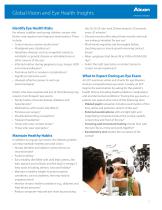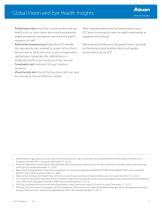 Website:
Alcon
Website:
Alcon
Catalog excerpts

Maintaining Good Eye Health How to preserve vision and care for eyes Did you know that many eye health and vision problems present no obvious signs or symptoms, which makes it difficult for patients to know they exist? There’s one easy way to solve this issue: schedule a regular eye exam with your eye care professional (ECP). More than 80% of all visual impairment is treatable, preventable or curable, so early diagnosis and care are critical.1 Schedule Regular Eye Exams Below are recommended guidelines for eye examination intervals by patient age.7 Recommended Eye Examination Frequency by Patient Age7 Patient Age Before Age 3 Risk-Free Patients Children should have their eyes screened during their regular pediatric appointments. Vision testing by the primary care provider is recommended for all children starting around 3 years of age Every one to two years during regular pediatric or family physician check-up appointments At least once between the ages of 20 and 29 and at least twice between the ages of 30 and 39 Patients should receive a baseline eye disease screening at age 40. Based on the results of the initial screening, an ECP will prescribe the necessary intervals for follow-up exams Seniors age 65 and over should have complete eye exams every one to two years For individuals at any age with symptoms of or at risk for eye disease, such as those with a family history of eye disease, diabetes or high blood pressure, it is recommended that individuals see their ophthalmologist to determine how frequently their eyes should be examined.7
Open the catalog to page 1
Global Vision and Eye Health Insights Identify Eye Health Risks For infants, toddlers and young children, certain risks factors may require more frequent examinations. These include: • Central nervous system dysfunction2 • Misaligned eyes (strabismus)2 • Hereditary diseases such as congenital cataracts, metabolic or genetic disease or retinoblastoma or other cancers of the eye2 • Infected mother during pregnancy (e.g., herpes, AIDS and venereal disease)2 • Premature birth or newborn complications2 • Significant refractive error2 • Unequal refractive power in each eye (anisometropia)2 Adults...
Open the catalog to page 2
Global Vision and Eye Health Insights • Preliminary tests check for visual function and eye health such as color vision, eye muscle movements, depth perception, peripheral vision and the pupil’s response to light6 • Refraction measurement helps the ECP identify the appropriate lens needed to correct vision that is blurred due to refractive error, such as myopia(nearsightedness), hyperopia (far-sightedness) or astigmatism(off-round curvature of the cornea)6 • Tonometry test measures the eye’s internal pressure6 • Visual acuity test checks for how clear each eye sees by measuring near and...
Open the catalog to page 3All Alcon catalogs and technical brochures
-
PUREPOINT
2 Pages
-
Vektor
2 Pages
-
NEGENUITY
2 Pages
-
CONSTELLATION®
4 Pages
-
MODEL MA50BM
11 Pages
-
The LenSx® Laser System
12 Pages
-
CZ70BD
7 Pages
-
MODEL SN6AT3, SN6AT4, SN6AT5
23 Pages
-
MODEL SN60AT
9 Pages
-
MODEL SN6AD1
26 Pages
-
MODEL MA30AC
11 Pages
-
MODEL MN60AC
13 Pages
-
MODEL SN60WF
15 Pages
-
MODEL SN6CWS
15 Pages
-
NAPHCON A
1 Pages
-
PUREPOINT
6 Pages
-
CONSTELLATION® Vision System
10 Pages


























